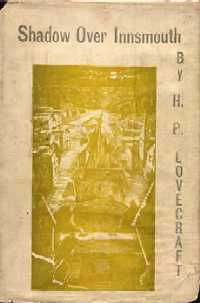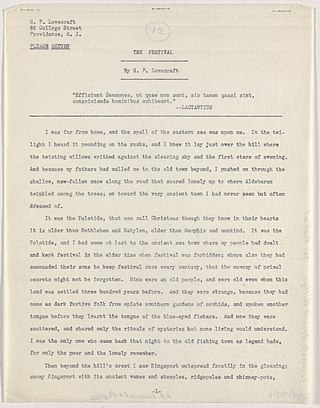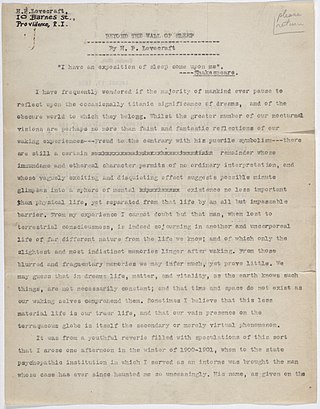
The Shadow over Innsmouth is a horror novella by American author H. P. Lovecraft, written in November–December 1931. It forms part of the Cthulhu Mythos, using its motif of a malign undersea civilization, and references several shared elements of the Mythos, including place-names, mythical creatures, and invocations. The Shadow over Innsmouth is the only Lovecraft story that was published in book form during his lifetime.

"The Nameless City" is a short horror story written by American writer H. P. Lovecraft in January 1921 and first published in the November 1921 issue of the amateur press journal The Wolverine. It is often considered the first story set in the Cthulhu Mythos world. In the story, the protagonist travels to the middle of the Arabian Desert to explore an ancient underground city.

"Pickman's Model" is a short story by H. P. Lovecraft, written in September 1926 and first published in the October 1927 issue of Weird Tales.

"In the Walls of Eryx" is a short story by American writers H. P. Lovecraft and Kenneth J. Sterling, written in January 1936 and first published in Weird Tales magazine in October 1939. It is a science fiction story involving space exploration in the near future.

"The Outsider" is a short story by American horror writer H. P. Lovecraft. Written between March and August 1921, it was first published in Weird Tales, April 1926. In this work, a mysterious individual who has been living alone in a castle for as long as he can remember decides to break free in search of human contact and light. "The Outsider" is one of Lovecraft's most commonly reprinted works and is also one of the most popular stories ever to be published in Weird Tales.

The Shadow Out of Time is a novella by American horror fiction writer H. P. Lovecraft. Written between November 1934 and February 1935, it was first published in the June 1936 issue of Astounding Stories. The story describes time and space travel by mind transfer, where a person in a given place and time can switch bodies with someone who is elsewhere or elsewhen. As with other Lovecraftian works, this story features otherworldly alien beings that are not simply variations on humans or other familiar terrestrial animals.

"Dagon" is a short story by American author H. P. Lovecraft. It was written in July 1917 and is one of the first stories that Lovecraft wrote as an adult. It was first published in the November 1919 edition of The Vagrant. Dagon was later published in Weird Tales in October 1923. It is considered by many to be one of Lovecraft's most forward-looking stories.

"The Festival" is a short story by H. P. Lovecraft written in October 1923 and published in the January 1925 issue of Weird Tales.
"Polaris" is a fantasy short story by American author H. P. Lovecraft, written in 1918 and first published in the December 1920 issue of the amateur journal The Philosopher. It is the story that introduces Lovecraft's fictional Pnakotic Manuscripts, the first of his arcane tomes.
"The Black Stone" is a horror short story by American writer Robert E. Howard, first published in the November 1931 issue of Weird Tales. The story introduces the character of Justin Geoffrey, a mad poet, and the fictitious book Unaussprechlichen Kulten by Friedrich von Junzt. The story is part of the Cthulhu Mythos, and follows the same pattern and has the same features as much of H. P. Lovecraft's classic work.

"Hypnos" is a short story by American horror fiction writer H. P. Lovecraft, penned in March 1922 and first published in the May 1923 issue of National Amateur.
"The Temple" is a short story written by H. P. Lovecraft in 1920, and first published in the pulp magazine Weird Tales #24 in September 1925.

"The Strange High House in the Mist" is a short story by H. P. Lovecraft. Written on November 9, 1926, it was first published in the October 1931 issue of Weird Tales. It concerns a character traveling to the titular house which is perched on the top of a cliff which seems inaccessible both by land and sea, yet is apparently inhabited.

"What the Moon Brings" is a prose poem by American horror fiction writer H. P. Lovecraft, written on June 5, 1922. This story was first published in the National Amateur in May 1923. It's shorter than most of Lovecraft's other short stories, and is essentially a fragment. The story is based on one of Lovecraft's dreams, a common technique.

"He" is a short story by American horror writer H. P. Lovecraft. Written August 1925, it was first published in Weird Tales, September 1926.
"The Evil Clergyman" is an excerpt from a letter written by American horror fiction writer H. P. Lovecraft in 1933. After his death, it was published in the April 1939 issue of Weird Tales as a short story. The story was later adapted into the unreleased 1987 anthology film Pulse Pounders.
The Mound is a horror/science fiction novella by American author H. P. Lovecraft, written by him as a ghostwriter from December 1929 to January 1930 after he was hired by Zealia Bishop to create a story about a Native American mound which is haunted by a headless ghost. Lovecraft expanded the story into a tale about a mound that conceals a gateway to a subterranean civilization, the realm of K'n-yan. The story was not published during Lovecraft's lifetime. A heavily abridged version was published in the November 1940 issue of Weird Tales, and the full text was finally published in 1989.

"Beyond the Wall of Sleep" is a science fiction short story by American writer H. P. Lovecraft, written in 1919 and first published in the amateur publication Pine Cones in October 1919.
Robert Hayward Barlow was an American author, avant-garde poet, anthropologist and historian of early Mexico, and expert in the Nahuatl language. He was a correspondent and friend of horror writer H. P. Lovecraft, who appointed Barlow as the executor of his literary estate.
"Till A' the Seas" is a post-apocalyptic short story by American horror fiction writer H. P. Lovecraft and R. H. Barlow. The title is a reference to the poem "A Red, Red Rose" by Robert Burns.













